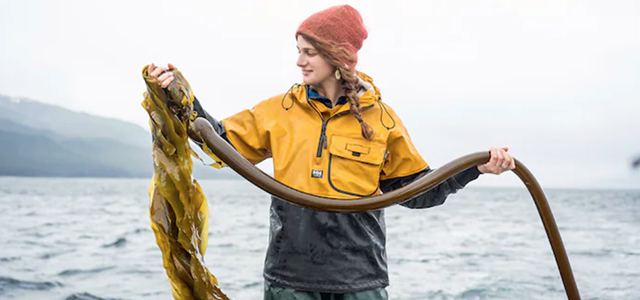||| FROM THE WASHINGTON POST |||
Warner’s face lights up as she inspects the seaweed. “They’re ready for harvest,” she declares.
As the CEO and president of Atlantic Sea Farms, the 38-year-old Warner is using seaweed to quietly revolutionize Maine’s struggling fishing industry.
Up and down the Maine coast, thousands of lines like this have been planted by fishermen growing seaweed in partnership with her company. In the fall, the fishermen plant tiny kelp seeds on the 1,000-foot-long ropes, and by late spring, attached to each one is close to 6,000 pounds of fresh sugar kelp. The seaweed is harvested, flash frozen and used to make kelp cubes for smoothies, as well as seaweed salad, seaweed kraut and more.
Seaweed is Maine’s new cash crop.
For generations, coastal Maine has been supported by a different underwater resource: the lobster. Lobstering is woven into virtually every aspect of life in coastal communities; tax revenue, jobs, and the state’s identity all depend on it. But as climate change causes Maine’s coastal waters to warm, underwater life, and the economy built around it, has shifted dramatically.
The Gulf of Maine is warming faster than 96 percent of the world’s oceans — increasing at a rate of 0.09 degrees per year. These warming temperatures have forced the lobster population to migrate north seeking colder waters, and the impact on Maine fishermen has been profound.
Keith Miller, 67, a second-generation lobsterman, has been lobstering for more than 50 years, fishing in Wheeler’s Bay between Spruce Head and Tenants Harbor. When he saw the dramatic impact of climate change on his industry he knew he had to plan for the six months of the year — between fall and spring — when he couldn’t fish for lobster. He heard about a program in Rockland, Maine, at the Island Institute (which helps coastal communities thrive) educating lobstermen about aquaculture.
“I could choose between oyster farming, mussel farming or kelp,” says Miller in his thick Maine accent. “Water ’round here is too shallow for mussels, and oysters are a year-round job. I wanted to keep lobstering half the year, so I chose seaweed.”
At the time, Warner was the Island Institute’s first economic development officer. A former Foreign Service diplomat, she says she’s always been interested in “finding solutions rather than being part of the problem.” After serving in Libya, Guinea and several other countries, she moved to Maine with her husband (who grew up in the state) and started a family. Her goal was to apply her diplomatic skills to making a difference in the state’s coastal and food communities.
“The question we asked was this: In communities where lobster is everything, how do we prepare for the future along the Maine coast and diversify to face climate change?” says Warner. “When you’re self-employed and your entire community is dependent on one industry, and you’re totally at the whim of Mother Nature, overdependence on one monoculture is very scary.”
Miller is one of several dozen lobstermen accepted into the aquaculture program. He describes the last five years he’s spent farming seaweed in the “offseason” as “life changing.”
“My first year kelping I brought in 2,200 pounds,” he says. “But this year my harvest was 170,000 pounds. I keep telling folks, ‘My ship is coming in!’”











Excellent article! Be sure to read the whole thing. Seaweed is AMAZING and it grows prodigiously in our waters. I use sugar kelp in virtually every soup, stew and sauce that I make.